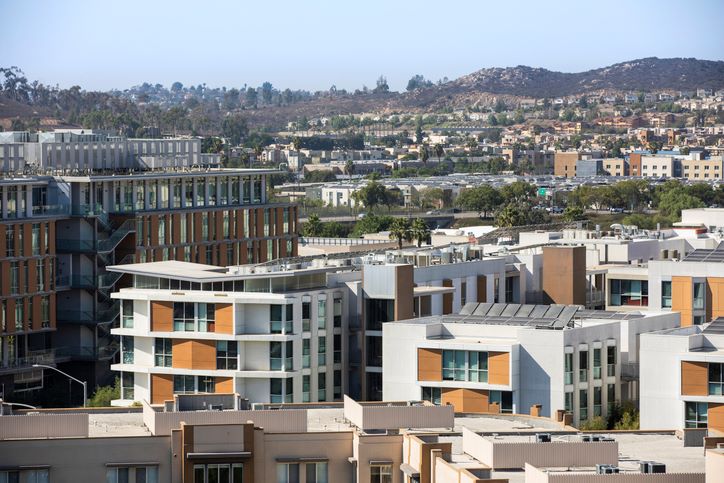A new Brief by the Terner Center for Housing Innovation at UC Berkeley reports on the results of a legislative review of more than 100 bills related to increasing housing production that have passed since 2017, and 22 interviews the authors conducted with stakeholders like land use attorneys and city planners across the state.
The report finds that while progress has been made to speed up housing production, several barriers remain that have limited California’s ability to meet demand. The Brief states, “The Center for Continuing Study of the California Economy recently concluded that residential building permits increased 15.5 percent in the first six months of 2022, with most of that increase occurring in multifamily (apartment buildings) permits.” There has also been an increase in the development of Accessible Dwelling Units (ADUs), small, independent housing units built on the grounds of an existing housing unit.
The Brief also affirms that enhancing Regional Housing Needs Assessment (RHNA) requirements for housing production from individual cities has contributed to a ramp-up in planning for more housing. The report states, for example:
“The RHNA target figure for the Southern California Association of Governments (SCAG) region increased from 412,000 units in the fifth cycle to 1.3 million in the sixth cycle. The target number for the Association of Bay Area Governments (ABAG) grew from 188,000 in the fifth cycle to 445,000 in the sixth cycle. This significant increase has caused local cities and counties to increase the densities permitted on residential projects and change their zoning ordinances in other ways to accommodate these higher numbers.”
Localities that fail to submit a housing element that meets RHNA metrics lose out on state-funded assistance to build affordable housing. They are also subject to something called “The Builder’s Remedy,” which requires immediate administrative approval for projects that can claim 20 percent affordable units, without planning commission or city council review and approval.
Legislation has also provided an additional enforcement mechanism. Through 2017’s Assembly Bill 72, the Housing and Community Development Department (HCD) at the state level can revoke a previously granted approval of a city’s housing element if it is later shown to be out of compliance. The law allows the HCD to report such findings to the State Attorney General, who has shown a willingness to sue cities that have fallen out of compliance, as Attorney General Rob Bonta did in suing a very resistant Huntington Beach.
There is also additional enforcement through advancement in the state’s program to Affirmatively Further Fair Housing in California. The passage of Assembly Bill 686 in 2018 added new requirements to comply with Federal law. The program now, “requires cities to analyze patterns of residential segregation and rezone affluent, historically exclusive areas (which tend to be zoned solely for single-family homes) for multifamily use.”
Changes in the state’s Density Bonus Law (DSL) have also spurred cities to plan for more housing. The Terner Brief affirms that, “Specifically, 12 bills have been passed that have expanded the applicability and incentives available to developers. Our interviewees noted that the combination of all of these changes has made DBL much more beneficial to use, resulting in more units and greater project feasibility.” In addition, another DBL-related reform came in 2018’s Assembly Bill 2372, which allowed cities to grant a floor area ratio (FAR) bonus instead of a density bonus, and also limits parking requirements on developers to make projects more feasible.
In a related note on parking, the legislature passed just last year Senate Bill 2097, which prevents cities from requiring parking to be built for residents if the development falls within a half mile of certain transit stops.
The Terner Brief also credits the combination of 17 bills related to ADUs for ramping up their production, stating that, “in 2016, California permitted just over one thousand ADUs. In 2021, over 20,000 ADUs were permitted.”
One recently passed law has not seen the traction its sponsors had hoped for, however. When Senate Bill 9 passed in 2021, it was immediately controversial because it mandates ministerial approval for duplexes and lot splits in areas that were originally zoned for single-family homes. The Terner Center itself admits that it said at the time the law could lead to the development of up to 700,000 additional homes that would otherwise not have been feasible in those neighborhoods. But unfortunately, according to the Brief, SB 9 “Has yet to translate into similar increases in duplexes, in part because some localities are finding ways to hinder implementation through local ordinances with requirements such as front setback or easement requirements for newly subdivided lots.”
Several pieces of legislation have also aimed at streamlining the permitting process. The first, originally passed in 1982 as the Housing Accountability Act (HAA), ensures projects won’t be denied if they are compliant with local land use regulations. Three bills passed in 2017, SB 167, AB 678, and AB 1515, were designed to strengthen the original HAA. The combination allows for the “developer-friendly standard of review” to be used, which is that a project meets local land use rules with a “preponderance of evidence” rather than “substantial evidence.” Another bill, SB 330, also known as “the Housing Crisis Act of 2019,” specifically, according to the Brief, “Limited cities’ ability to deny permits in several ways. It created a non-discretionary ‘preliminary application’ that vests rights upon submission, establishes a private right of action for challenging permit denials, allows plaintiffs to win attorneys’ fees, and requires that changes to zoning ordinances do not result in a net loss of residential capacity within the jurisdiction.”
Finally, there has been a lot of legislative focus on making sure the California Environmental Quality Act (CEQA) is no longer so easily used to block housing development. Even when CEQA challenges don’t prevent a housing development from ultimately being built, the legal delays add costs and costly delays to projects, which often result in fewer units being built due to feasibility factors changing. Several bills have passed that have increased the number of exemptions for certain projects so that CEQA cannot be applied.
Ultimately, the Terner Center Brief concludes that in some ways, it’s too early to know if the last five years of legislation will make their desired impact. But they also say that through the interview portion of the study, they have three reasons for cautious optimism.
- They heard from their interviews that the legislation is definitely working to spur the production of ADUs and subsidized affordable housing
- New laws have encouraged a cultural shift toward cities’ willingness to say yes to projects, as the legislation has sent “A signal to city staff and elected officials that housing is a matter of statewide importance and cities need to do their part”
- Interview subjects affirmed for them that new, higher RHNA demands and other changes to Housing Element Law will have a powerful effect
They also acknowledge, however, that they repeatedly heard that, “high development costs—such as labor, materials, development impact fees, and stringent building code requirements— continue to impede housing development in even the most permissive cities and counties.”
Leonora Camner, Executive Director of Abundant Housing LA, a group that advocates more housing be built at all levels of affordability, said of the Brief, “We are encouraged by the Terner Center’s recent report, which illustrates the powerful progress achieved in California’s housing policy, thanks in part to the dedicated advocacy of Abundant Housing LA and our partners. However, we recognize that there is still much work ahead to address the ongoing housing crisis. We remain committed to advising on and advocating for legislation that fosters equitable housing opportunities for all Californians and breaks down barriers to development. As we go forward, we urge policymakers and stakeholders to join us in addressing the underlying cost drivers and providing the necessary financial incentives to create a more abundant and affordable housing landscape in our state.”
We’ll all have to see if California meets the moment.
Photo by MattGush
Stay informed. Sign up for The Westside Voice Newsletter
By clicking submit, you agree to share your email address with Westside Voice. We do not sell or share your information with anyone.








